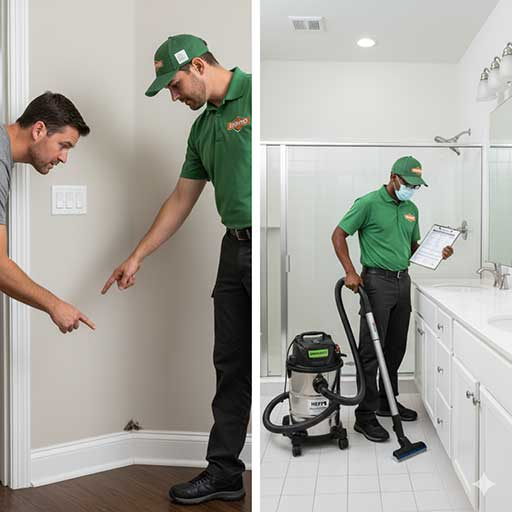
Scope & limits (disclaimer)
Informational content only. No booking flows, ZIP finders, phone prompts, coupons, or CTAs; no proximity language (e.g., “near me,” “in your area”). Topics are limited to non-remediation cleaning practices relevant to senior households. This content focuses strictly on the practical, procedural aspects of cleaning services and household preparation. It does not offer advice on medical cleaning, remediation, or pathogen-specific interventions, and it should not be interpreted as a guarantee of results. Families and caregivers should consider these notes as operational guidance for organizing and understanding the type of deep cleaning that may be conducted in homes with older adults.
What a senior-oriented deep clean typically covers
Teams generally follow a written scope and room-by-room checklist to ensure thoroughness and consistency. Common areas addressed include:
-
Kitchen: degreasing of hobs, ovens, and extraction hoods; cleaning of splashbacks; exterior wipe-down of appliances; interiors of appliances if pre-agreed; attention to high-touch points such as drawer pulls, handles, and switches. Additional care is taken to avoid splashes that could create slip hazards.
-
Bathrooms: removal of soil and mineral build-up; non-remediation mildew cleaning; ventilation grille wipe-downs; cleaning of fixtures, switches, and other high-touch surfaces. Staff often use low-splash methods to avoid creating excess moisture on the floors.
-
Floors & textiles: HEPA vacuuming of all accessible areas; where included in the scope, low-moisture extraction for upholstery or carpets; emphasis on drying surfaces quickly and safely, especially in wet areas. This minimizes slip hazards and ensures that surfaces are safe for daily use.
-
High-touch disinfection: door handles, banisters, light switches, desk edges, and remote controls are cleaned following label contact times. Staff use methods to prevent cross-contamination, including color-coded cloths or separate tools for kitchens and bathrooms.
Exact tasks depend on the written scope agreed with the provider, and families should confirm what is included before the visit.
Disinfection protocols (methods, not marketing)
A typical sequence follows operational best practices: pre-cleaning, application of disinfectant, adherence to contact times, and prevention of cross-contamination. These steps are applied in a surface-appropriate manner. No claims are made about pathogen-specific efficacy. Providers generally select products suitable for the surfaces in question and confirm that instructions are followed according to labels. Families should not interpret this information as a guarantee of complete sanitization against any particular organism.
Senior-friendly adjustments (non-medical)
Households with older adults or individuals with limited mobility often require operational modifications:
-
Long-reach dusters and low-splash application for showers or baths.
-
Slip-aware floor care, including immediate drying of damp surfaces.
-
Low-odor or fragrance-free products upon request.
-
Extra focus on high-touch zones, such as banisters, appliance handles, and faucets.
These adaptations are intended to increase safety and comfort during cleaning and are not medical services or remediation measures.
Planning & expectations (neutral)
Families are encouraged to align on a written scope, availability window, and any sensitivities, such as fragrance-free preferences, ventilation requirements, or grab-bar attention. Clarify in advance if interior appliance cleaning or soft-surface work is included. Expectations should focus on procedural adherence rather than guaranteed outcomes.
Quality you can review
Some providers increase transparency with measures such as:
-
A brief walk-through at the start of the visit to note priorities and delicate surfaces.
-
A visible task checklist that crews mark off during service.
-
An end-of-visit summary outlining completed tasks and care guidance, including recommended drying times or special surface considerations.
Policies differ, so families should confirm these practices in writing before the visit.
Materials & surface care (examples)
Thorough cleaning does not mean harsh treatment:
-
pH-appropriate cleaners for stone; non-etch formulas for glass; peroxide blends for bathroom surfaces when suitable; neutralizers after heavy degreasing.
-
HEPA vacuuming followed by damp-wiping to limit re-aerosolization of fine dust.
-
Fragrance-free options for sensitive occupants.
-
Delicate surfaces disclosed during the walk-through may be protected or skipped.
Illustrative scenarios (not guarantees)
-
Move-in / Move-out: deep cleaning of kitchens and bathrooms, appliance interiors if scoped, baseboards, and textiles as included.
-
Post-construction dust: multi-pass HEPA vacuuming, damp-wipe of horizontal surfaces and vents.
-
After a household illness: high-touch cleaning and disinfection per label instructions; soft-surface refresh if included.
-
Pet or smoke odor: targeted textile care and odor control with controlled moisture and extraction.
Outcomes vary depending on materials, soil levels, and agreed-upon scope.
Simple prep checklist for families
-
Share sensitivities (fragrance, asthma) and mobility notes in advance.
-
Clear essential walkways (bed ↔ bathroom, favorite chair ↔ kitchen).
-
Set aside personal items or medications; label any do-not-clean zones.
-
Optionally request a brief post-visit note with observations or care reminders.
This information provides families with practical guidance on organizing and understanding senior-oriented deep cleaning while maintaining realistic expectations and prioritizing safety and comfort.